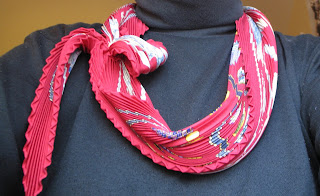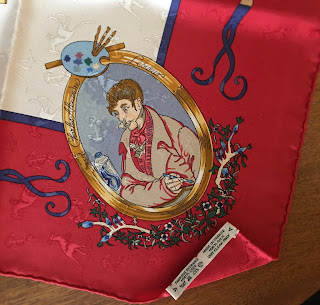Two frozen
chicken breasts, salted, and put in a 180ºF oven (yes, that's less than 200ºF) for 2-3 hours will be done and tender and no-muss-no-fuss. One will be used to make 16 cups of soup. One will be dinner for the next couple of days.
While they are cooking, slice two ribs of
celery, 1/2 large
onion.
Add some olive oil to your pot ((I use the 7-quart Cuisinart cast iron and enamel pot (Yep, it's the same one I use for
no-knead bread.)) and lightly cook the onion and celery.
Add water and
Minor's Flavor - it's a vast improvement on bouillon. (You can get it on Amazon, if it's not in your store, and it probably isn't.)
Peel and put 1 large
carrot into the microwave to precook. (My microwave has a sensor-cook setting. Don't know what yours has.) A precooked carrot is a breeze to slice/chop.
Add sliced carrot and sliced
mushrooms (two huge ones were plenty) to the stock pot.
Here's a trick I learned from America's Test Kitchen. Into a cup of water, float a couple of teaspoons of
gelatin. When it softens, mix it up and add it to the pot. It sounds odd, but gelatin is released by bones during the long simmer of a chicken. This recipe has no bone-broth, so you can fake it with gelatin. It improves the mouth-feel of the soup. It's what makes soup taste rich and smooth, not thin.
When the veggies are done, add
pasta. My choice would be Israeli Couscous - which are little balls, bigger than B-Bs. But this soup is for D, and the preference is for
Orzo.
Orzo looks like rice. But orzo means barley in Italian. Go figure. Actually you can add noodles or any of the small pastas, like tubetti, little shells, bow-ties, alphabets, broken spaghetti, etc. Don't overcook the pasta, since it continues to cook after the pot is turned off and then expands. About 100 grams of dry pasta is plenty.
Add the cooked chicken and serve. The soup freezes well, so we always have containers of soup in the freezer.
Change it Up!
Sometimes I put sliced
garlic into the soup.
I have also added sliced
lemon to the simmering stock depending on my mood.
A splash of white
wine is good!
Fresh herbs at the last minute are great. We like
parsley and
chives. (Thanks, Karen, for the chive plants!)
If you like a more "yellow" broth, do not use red onions (we use what we have. . . ) or mushrooms.
Italians often sprinkle
parmesan cheese on their soup at the table.
I like to let little chunks of
cheddar cheese melt in my bowl.
~*~*~*~*~
If you have discovered other tips, please share them!
One friend buys a rotisserie chicken from the supermarket and enjoys several roast-chicken meals. Then she puts the carcass into the stock pot and simmers to make her stock! Great idea, Mary!

































